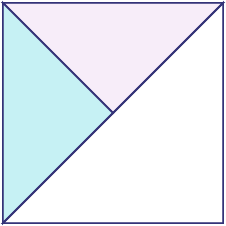E2.7 Compare the areas of two-dimensional shapes by matching, covering, or decomposing and recomposing the shapes, and demonstrate that different shapes can have the same area.
Activity 1: Twin Surfaces
Goal
In this activity, students find rectangles with equal areas and justify their answers.
Materials
- sticky notes
- Appendix 1.8
Instructions
Form teams of two. Give each team a copy of Appendix 1.8. Ask teams to find two rectangles with the same surface area without measuring. Have teams check their estimates by covering the areas of the two rectangles with sticky notes. If their estimate is not correct, ask the question,”How do you know the area is or is not the same?"
The student must then try to find a rectangle with an area of the same size.
Source: translated from Guide d’enseignement efficace des mathématiques, de la maternelle à la 3e année, Mesure, p. 131.
Activity 2: Composition and Decomposition of Areas
Goal
In this activity, students use pieces of a tangram to construct shapes with areas of equal size. They use a string to determine the perimeter.
Materials
- tangram set (one per team)
- pieces of string (one string per team)
- sheets of graph paper (one sheet per team)
- scissors (one pair per team)
- loose leaf (one sheet per team)
Instructions
Form teams of four and give each team a tangram, a sheet of graph paper, string and a pair of scissors.
Have students assemble the tangram pieces to form a square, use a string to trace its outline and cut it to length. Tape the string to a piece of loose leaf. Have students use the tangram pieces to construct three more shapes of their choice.
If a student is having difficulty putting the tangram pieces together into a square, give them tips or ideas (for example, place the two large triangles in a corner as in the picture below)

For each shape created, ask students to:
- trace the outline of the shape on a sheet of graph paper;
- determine the area of the shape;
- trace the outline of the shape with a string and cut it to the right length;
- glue the string on the loose leaf;
- record measurements of perimeters and areas of shapes in their mathematical notebook.
Some teams could use a tangram set on the interactive board and follow the same process to create a shape and determine its area or perimeter, or each team could construct a shape on the interactive board. Once the shape is created, it can be printed and the activity continued.
Take turns inviting teams to present their results. Facilitate a discussion by asking questions such as:
- What does the length of the strings represent? (The length around the shape, the perimeter of the shape, the distance around the shape, etcetera)
- What do you notice about the perimeter of the shapes? (Not all shapes have the same perimeter, some shapes have the same perimeter.)
- Why did you get different results even though you used the same pieces of the tangrams? (The sides of the pieces were juxtaposed or were arranged differently.)
- What do you notice about the area of the shapes? (The shapes all have the same area.)
- How did you get this result? (We counted the squares covered by the pieces on the grid paper. We used the same tangram pieces, so the areas of the pieces have the same area even if the orientation of the shapes changes.)
During the discussion, support students to recognize that:
- all surfaces of the shapes have the same area since they are assembled with the same parts;
- not all forms have the same perimeter.
Source: translated from Guide d’enseignement efficace des mathématiques, de la maternelle à la 3e année, Mesure, p. 166-167.
Activity 3: Shapes in Order of Size (Area)
The teacher places six different irregular shapes on the four walls of the classroom, of which two pairs of shapes have the same area (see Appendix 1).
Students are provided with scissors, cardboard paper, string, sticky notes, pencils, and 1 cm x 1 cm grid paper (see Appendix 2).
Context is given to students.
- In a math contest, participants were given the following challenge: without using a ruler, place the shapes in order from smallest to largest area.
- You are allowed to bring only one shape at a time to your desk and you may not write on it.
- How can you solve this problem?
A mathematical conversation should follow this activity so that students can present their strategies. This encourages discussion and allows students to realize that multiple strategies can be adopted to solve the same problem.
Source: translated from L'@telier - Ressources pédagogiques en ligne (atelier.on.ca), p. 1.
Activity 4: Comparing Areas - Pattern Blocks
Goal
In this activity, students compare the measurement of the area of different pattern blocks.
Materials
- A set of pattern blocks for each student
Instructions
Give students the following geometric pattern blocks: green triangles, blue rhombuses, red trapezoids, yellow hexagons.
Ask questions such as:
- Which pattern block has the least area?
- Which pattern block has the greatest area?
- What method did you use to compare the areas of the pattern blocks?
- Which area is greater, that of the rhombus or that of the trapezoid?
- How many triangles placed next to each other have the same area as the rhombus?
- Which pattern blocks put together to have the same area as the trapezoid?
- How many triangles are required to cover the hexagon?
- Which pattern blocks put one next to the other have the same area as the hexagon?
Source: translated from L'@telier - Ressources pédagogiques en ligne (atelier.on.ca), p. 1.
